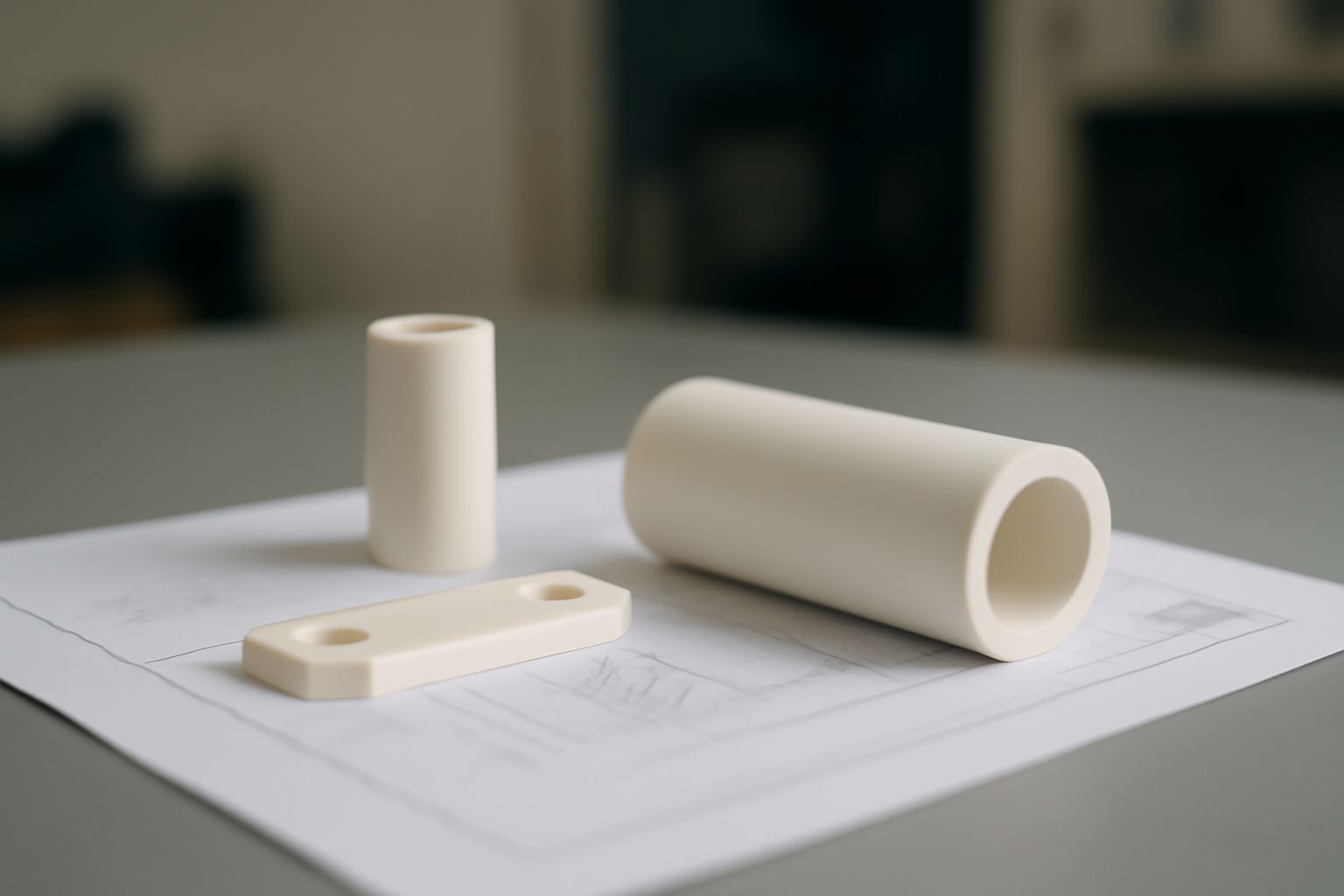Die Sonderbestellung von Aluminiumoxidkeramik erfordert eine präzise Umsetzung der Zeichnung in Einzelteile, die Einhaltung enger Toleranzen und klare Vorgaben hinsichtlich der Prototypenfertigung im Vergleich zu Massenlieferungen. Käufer erhalten eine übersichtliche Checkliste mit technischen Zeichnungen, Oberflächenbeschaffenheit, Messtoleranzen und Faktoren, die Lieferzeit und Preis beeinflussen. Das minimiert Kommunikationsprobleme und vermeidet Fehler.

Wie werden Zeichnungen in maßgeschneiderte Aluminiumoxidkeramikkomponenten umgewandelt?
Präzise Konvertierung von technische Zeichnungen hinein Aluminiumoxidkeramikteile hängt von klarer Kommunikation und fachkundiger technischer Überprüfung ab. Bei CSCERAMIC stelle ich sicher, dass jede Kundenzeichnung DFM-Prüfungen (Design for Manufacturability) durchläuft, um Abmessungen, Toleranzen, Materialhinweise und kritische Merkmale in eine produktionsreife Spezifikation zu übersetzen. Unsere Ingenieure fordern in der Regel 2D- und 3D-Dateien (vorzugsweise STEP oder PDF) an und bestätigen Details wie die Materialqualität (z. B. 99,7 % Al 2 O 3 ), geometrische Merkmale und Verarbeitung. Unklarheiten führen zu hin- und hergehenden Klärungen. Daher rate ich meinen Kunden dringend, jede Funktionsfläche, Passungs-/Freiraumzone und Leistungsanforderung im Voraus zu kennzeichnen. Dies minimiert Fehler bei der CNC-Bearbeitung oder beim isostatischen Pressen, was sich direkt auf die Teiletauglichkeit und die Projektzeitpläne auswirkt.
Nachfolgend finden Sie die wichtigsten Kontrollpunkte, die ich empfehle:
| Checklistenpunkt | Was zu bestätigen ist |
|---|---|
| Zeichnungsformat | PDF/STEP-Datei, vollständige Bemaßung, Schnittansichten, Notizen |
| Materialspezifikation | Aluminiumoxid-Reinheit (min. 99,5 %, typischerweise 99,7 % Al 2 O 3 ) |
| Toleranz & Passform | Kritische Abmessungen gekennzeichnet, im Allgemeinen ±0,05 mm, sofern nicht enger angegeben |
| Oberfläche & Besondere Hinweise | Polier-/Finishgrad, funktionale/kritische Bereiche, Anwendungskontext |
Welche Toleranzen und Oberflächengüten sind bei Präzisionsteilen erreichbar?
Im fortgeschrittenen Herstellung von Aluminiumoxidkeramik Standardtoleranzen von ±0,05 mm für gerade Abmessungen und ±0,02 mm für Außen-/Innendurchmesser werden bei CSCERAMIC für kritische Anwendungen regelmäßig erreicht. Je nach Bearbeitungskomplexität und Teilegeometrie empfehle ich oft eine Standard-Allgemeintoleranz, betone aber die Notwendigkeit, nach Möglichkeit engere Anforderungen in der Zeichnung anzugeben. Unsere Nachbearbeitung nach dem Sintern und die Diamantbearbeitung ermöglichen eine typische Oberflächenrauheit von Ra ≤ 0,8 µm, mit Feinpolitur bis Ra ≤ 0,3 µm auf Anfrage für elektronische, Vakuum- oder Dichtungsflächen. Hinweis: Je enger Ihre Spezifikationen, desto mehr technische Planung und zusätzliche Qualitätssicherungsschritte sind erforderlich, was sich manchmal auf Ertrag und Kosten auswirkt.
| Parameter | Erreichbare Reichweite | Branchenreferenz |
|---|---|---|
| Maßtoleranz (AD/ID) | ±0,02 mm (auf Anfrage) | Eigenschaften von Aluminiumoxid (Wikipedia) |
| Ebenheit/Geradheit | ≤0,05 mm/100 mm | Technisches Datenblatt von Kyocera |
| Oberflächenrauheit (Ra) | ≤0,8 µm Standard, ≤0,3 µm Politur | Insaco-Toleranzrichtlinien |
Wie funktionieren die Zeitpläne für Prototyping und Batchlieferung?
Keramik verstehen Lieferzeiten In jeder Projektphase hilft die Zusammenarbeit mit Auftraggebern, kostspielige Projektüberschreitungen zu vermeiden. Ich plane die Produktion von Prototypen (1–20 Stück) in der Regel innerhalb von 2–3 Wochen nach Zeichnungsbestätigung und Anzahlung, wobei ich interne Lagerbestände und eine flexible Planung nutze. Für die Serienproduktion (50–5000 Stück) rechnen Sie je nach Teilekomplexität und Auftragsgröße mit 4–6 Wochen. Jede Charge umfasst Qualitätssicherungsprotokolle und Messberichte. Sollten nach der Prototypenfreigabe technische Änderungen auftreten, wird die gesamte nachfolgende Planung anhand der aktualisierten Zeichnung zurückgesetzt, um die Prozessgenauigkeit zu gewährleisten und Verwirrungen zu vermeiden.
| Schritt | Lieferzeit | Haupthinweis |
|---|---|---|
| Prototyp/Kleinserie | 2–3 Wochen | Vorbehaltlich sofortiger Material-/Werkzeugbereitschaft |
| Serienproduktion | 4–6 Wochen | Komplexe Teile erfordern möglicherweise zusätzliche Bearbeitung und Qualitätssicherung |
| Zeichnungsänderung | Projektzeitpläne werden zurückgesetzt | Vermeiden Sie Mehrdeutigkeiten – bestätigen Sie das endgültige Design vor der Chargenproduktion |
Welche Variablen beeinflussen die Endkosten von kundenspezifischer Aluminiumoxidkeramik?
Die Hauptkostentreiber bei der individuellen Fertigung von Aluminiumoxidkeramik sind Teilegeometrie, erforderliche Toleranzen, Materialgüte und Losgröße. Meiner Erfahrung nach erhöhen komplexe Details (Schlitze, Löcher, dünne Wände) und engere Toleranzen sowohl die Bearbeitungszeit als auch die Ausschussquote und damit den Stückpreis. Hohe Reinheit (≥99,7 % oder Sondergüten) erhöht die Rohstoffkosten zusätzlich. Auch die Bestellmenge spielt eine Rolle – die Stückkosten sinken bei höheren Losgrößen dank der Amortisierung der Einrichtung deutlich. Schließlich erhöhen Zusatzwünsche wie Polieren, Prüfzertifikate oder spezielle Verpackungen das Gesamtangebot. Ich rate Einkäufern stets, Prioritäten zu klären (z. B. „nur Außenfläche poliert“ vs. „alle Flächen“), damit die Kosten den tatsächlichen technischen Anforderungen entsprechen.
| Kostenfaktor | Auswirkungen auf den Endpreis |
|---|---|
| Komplexität der Teilegeometrie | Komplexe/mehrachsige Designs, Hinterschnitte, dünne Wände kosten mehr |
| Toleranz & Verarbeitung | Engere Spezifikationen und polierte Oberflächen erhöhen die Qualitätssicherung und die Zykluszeit |
| Materialreinheit | ≥99,7 % Al 2 O 3 und höhere Qualitäten haben 10–20% Aufschlag |
| Bestellmenge | Höhere Stückzahlen reduzieren die Stückkosten um bis zu 30 % |
Zusammenfassend lässt sich sagen, dass detaillierte technische Zeichnungen und realistische Toleranzen für eine reibungslose und kostengünstige Bestellung von Aluminiumoxidkeramik unerlässlich sind. Frühzeitige Klarheit hilft Ihnen, Ihr Projekt im Zeit- und Kostenrahmen zu halten.




 info@csceramic.com
info@csceramic.com







 +86 18273288522
+86 18273288522